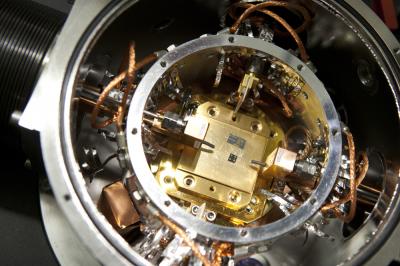Researchers have demonstrated a new way of achieving negative refraction in metamaterials. Researchers belonging to the Harvard School of Engineering and Applied Sciences (SEAS) and the Weizmann Institute of Science in Israel have collaborated to achieve the 'extraordinarily strong' negative refraction. They have reported a negative refractive index of -700.
 This is the chamber of the probe station where Donhee Ham's research group tests the new metamaterials. Credit: Photo by Eliza Grinnell, Harvard SEAS Communications
This is the chamber of the probe station where Donhee Ham's research group tests the new metamaterials. Credit: Photo by Eliza Grinnell, Harvard SEAS Communications
When compared to previous negative-index metamaterials, the present research brings negative refraction technology into a miniature area and the negatively refracting light is confined into a very small area.
While previous research in this area involved magnetic inductance, the present study considered kinetic inductance. According to Newton's law, kinetic inductance represents the unwillingness to change in the mechanical world. Kinetic inductance becomes more than magnetic inductance when electrons are confined flawlessly into two dimensions. The very strong negative refraction achieved in this study is due to the large 2D kinetic inductance.
Donhee Ham, Gordon McKay Professor of Electrical Engineering and Applied Physics at SEAS, the principal investigator of the project, and Hosang Yoon, a SEAS graduate student, utilized a 2D electron gas (2DEG) for the study. 2DEG forms at the aluminum gallium arsenide-gallium arsenide interface. The team sliced a 2DEG sheet into an array of strips. Then they utilized microwaves to hasten electrons in the leftmost strips. The adjacent strips feel the electron movements and the electrons get accelerated. The researchers considered this as a "staggering" degree of negative refraction.
The novel technology allows localization of electromagnetic waves into ultra-subwavelength scales which leads to a significant reduction in size. The concept may lead to development of powerful optical tweezers and microscopes which will enable study of individual molecules and viruses.
When terahertz waves are employed, the device could be operated at room temperature that presently operates below 20K. The researchers are investigating carbon structure graphene as a 2D conductor as electrons in graphene can show very large kinetic inductance.